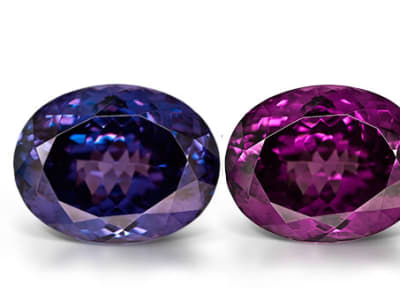Adularescence
Adularescence is an optical phenomenon typically associated with moonstone, a member of the feldspar family. It manifests as a soft shimmer moving within the gemstone as it is rotated. Adularescence occurs when light hits alternating layers of albite and orthoclase, two slightly differing forms of feldspar within the gemstone. These layers interfere with the passage of light, scattering its rays. The phenomenon is best seen when stones are fashioned as cabochons with the base parallel to the plane of the layers. The shimmer ranges in color from soft blue to milky white.
Cat's Eye
The term cat’s eye is used to describe an exotic optical property that is rarely seen in many gemstones. The effect, when present, appears as a bright, narrow slit – similar to what you see in the eyes of your favorite feline pet. This phenomenon is caused by parallel fibrous or needle-like inclusions. The inclusions interfere with the passage of light, which is scattered and reflected back to the viewer. The effect is best seen on gems cut en cabochon (a dome-shaped style lacking facets). When used by itself, the term cat’s eye always refers to the chatoyant variety of the mineral chrysoberyl. Any other gemstone exhibiting this optical property must have its name specified: quartz cat’s eye or cat’s-eye quartz, for example.
Color Change
Color change is an optical characteristic of a small number of gemstones. A color-change gemstone’s appearance varies when viewed in different lighting environments due to shifting wavelengths. Photochromism (or photochroism) is the technical term for color-change. The best-known color-change gemstone is alexandrite. When viewed in sunlight, this phenomenal variety of chrysoberyl appears greenish. Observed under incandescent light, the gemstone appears reddish. Other color-change gemstones include sapphire, garnet, spinel, diaspore and tourmaline.
Color Shift
Color shift is similar to color change, but more limited in scope. When exposed to different lighting environments, some gems will exhibit a small degree of change, generally within two adjacent colors of the visible light spectrum. The term color shift is used to describe this effect.
Fluorescence
Fluorescence is an optical property associated with many gemstones. It occurs when various forms of electromagnetic energy (ultraviolet light, infrared light or x-rays, for example) are absorbed by the host material, and some portion is re-emitted in the visible-light spectrum. Fluorescence is often used as a diagnostic tool when identifying gemstones.
Iridescence
Iridescence is an interference phenomenon that creates a prismatic, rainbow-like play of coloron the surface or within gemstones. Fire agate and ammolite are examples of two gemstones exhibiting this optical effect.
Play-of-Color
Play-of-Color is a phenomenon seen in precious opal. It is an effect created by a combination of diffraction and interference and is the result of the microstructure of opal. Opals are comprised of many layers of small, stacked spheres of silica. The spheres themselves act like diffraction gratings splitting the light into its spectral colors. The layers of spheres create interference allowing certain colors to dominate depending on the angle in which the opal is viewed and producing colors which seemingly "move" within the gem. The size, spacing and degree of ordered arrangement of the silica spheres determine which colors are visible.

